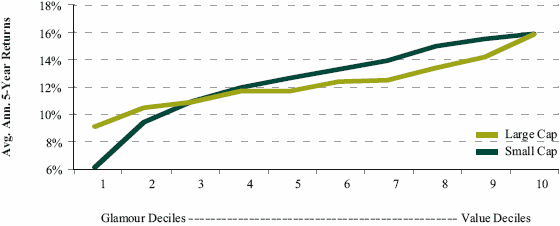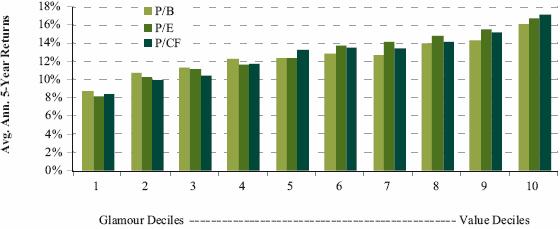How does the value premium fare when analysis appends data from the last few years to the data used in seminal studies? Does it persist, both in the U.S. and worldwide? In their October 2008 paper entitled “Value vs. Glamour: A Global Phenomenon”, the Brandes Institute refines and extends the duration of past value-growth research and expands its reach to global equity markets. The research focuses on price-to-book value ratio (P/B) as the principal value indicator, but also considers price-to-cash flow ratio (P/CF) and price-to-earnings ratio (P/E). Using stock returns and firm fundamentals for a broad sample of U.S. companies over the period April 1968-April 2008, and comparable data for 23 other country equity markets over the period June 1980-June 2008, they conclude that:
- The outperformance of value stocks persists in the U.S., with the top 10% of value (growth) stocks based on P/B generating an average annualized return of 16.2% (6.9%) over April 1968-April 2008. Value outperformance exists among both small and large capitalization stocks (see the first chart below).
- On an aggregated worldwide basis, the top 10% of value stocks outperforms the top 10% of growth stocks based on P/B by and average 7.4% per year over June 1980-June 2008, with similar results based on P/CF and P/E (see the second chart below). Outperformance of value holds again globally for both small and large capitalization stocks.
- Based on the global sample of five-year returns:
- There is no systematic weakening of the value premium over June 1980-June 2008.
- Value portfolio returns tend to be less volatile than growth portfolio returns.
- The value premium is evident or reasonably evident in 12 of 16 countries for which data is sufficient to support local analysis (including the U.S.).
The following chart, taken from the paper, summarizes the average annualized five-year returns for 20 portfolios of U.S. stocks formed by segmentation based on P/B, ten portfolios each for small and large capitalization stocks, over the period April 1968-April 2008. For both small and large firms, stocks with low P/B (value) outperform those with high P/B (“glamour” or growth), and performance varies consistently with P/B. The top 10% of small (large) capitalization value stocks outperform the top 10% of small (large) capitalization growth stocks by an average annualized return of 9.7% (6.8%).

The next chart, also from the paper, summarizes the average annualized five-year returns for 30 portfolios of aggregated global stocks, ten each formed by segmentation based on P/B, P/CF and P/E, over the period June 1980-June 2008. Regardless of the value-growth indicator applied, performance improves systematically from the growth (“glamour”) extreme to the value extreme.

The paper offers many other interesting charts.
In summary, the value premium among stocks is persistent across value indicators, time, market capitalizations and geographical markets.
Note that this study is proof-of-concept rather than proof-of-trading strategy. It does not account for trading frictions.